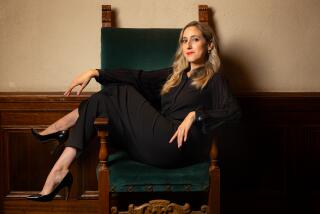Frederick Ashton: The Last of the Trio
- Share via
When I visited Sir Frederick Ashton in London about a year ago, he said, “Balanchine, Tudor’s gone, and now there’s only”--and he pointed ominously to himself. Now Ashton too has gone, the last surviving member of that trio of great choreographers of his generation, who in their different ways changed the look of ballet in our time.
Ashton’s death comes as a shock, because he had not been ill, though noticeably frailer in the last two or three years, after a couple of nasty falls.
But the last time I saw him, two months ago, he was cheerful, as quick-witted, even waspish, as ever, and pleased by the success of the recent revival by the Royal Ballet of his three-act ballet, “Ondine,” and also by that of “Rhapsody,” which had gone back into the repertory for the company’s Australian tour this summer, and which looked, as he said with characteristic modesty, a better ballet than he thought it was.
Many of us, greedy as always, hoped that he might create one more ballet, but it was not to be. He has gone, peacefully in his sleep, in his beloved Suffolk, as he would have wished.
He was, of course, the most English of choreographers, whose works defined the British style of classic ballet--well-mannered, lyrical, precise, eloquent, with an aristocratic sense of order.
Yet this formality was tempered by a sense of humor that could be as witty as a Wildean epigram or as broad as an English music-hall turn. Above all, the formality was humanized by passion--the word is not too strong to describe the way in which tenderness and physical love are expressed in such ballets as “La Fille Mal Gardee,” “Daphnis and Chloe,” “The Dream,” “Romeo and Juliet,” “Marguerite and Armand.”
Ashton was born in South America. He grew up in Lima, Peru, where in his early teens he saw Anna Pavlova. For him, this experience was the fairy’s kiss--”She injected me with her passion,” he once said--and from that moment on he wanted to be a dancer.
Ashton, sent to school in England by his family at the end of World War I, had to wait until he was 18 before he could begin to study ballet. But by 1926 he had started to choreograph.
There followed an astonishing stream of ballets, numbers for musical comedies, revues, films and television, opera stagings, cabaret acts--whatever might be required.
The history of Ashton’s career parallels that of British ballet itself, beginning with the pioneering days of Marie Rambert’s Ballet Club, the Camargo Society, and the Vic-Wells, which became first the Sadler’s Wells and then Royal Ballet, whose glory days came during his directorship, from 1963 to 1970.
Ashton was the first British choreographer to make a three-act ballet--”Cinderella,” in 1948. During the Sadler’s Wells Ballet’s first season as resident company at the Royal Opera House, Covent Garden, in 1946 his first postwar ballet, “Symphonic Variations,” was a kind of credo, an affirmation of his belief in classic ballet.
That belief never waivered; for him classic ballet was a language that could convey whatever he wished to express, from the austere, mathematical logic of “Scenes de Ballet,” to the elegiac poetry of “Enigma Variations,” his meditation on the loneliness of the creative artist.
Loneliness was something Ashton shared. He said of himself that he wanted to be loved. His most lasting relationships were with people he worked with, dancers like Margot Fonteyn and Alexander Grant, artistic collaborators such as Sophie Fedorovitch and Constant Lambert.
The love he wanted to give and receive was to be found in its purest form in his ballets, in moments like the one in “The Two Pigeons,” when the young woman turns her head for a last look back, and the young man, in a gesture of incomparable tenderness, reaches up and brings her head down onto his shoulder. The image many of us will retain of Ashton is that of his famous curtain calls, when he stood, nodding his head and waving, basking in the love that came to him across the footlights in the roars of applause.
More to Read
The biggest entertainment stories
Get our big stories about Hollywood, film, television, music, arts, culture and more right in your inbox as soon as they publish.
You may occasionally receive promotional content from the Los Angeles Times.










